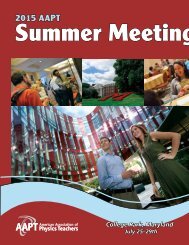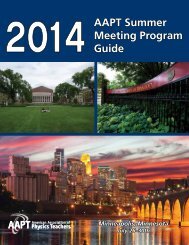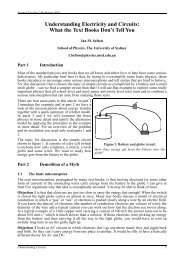final-program-12-23-14-3
final-program-12-23-14-3
final-program-12-23-14-3
Create successful ePaper yourself
Turn your PDF publications into a flip-book with our unique Google optimized e-Paper software.
Tuesday morning<br />
how physical theories are constructed and tested, to get a sense for<br />
what is currently on the forefront of physics, and to see what majoring<br />
in physics might be like. I will discuss trials, errors, and successes.<br />
GE04: 10-10:10 a.m. Outcomes of Learning Undergraduate<br />
Physics Through a Transdisciplinary Science Program<br />
Contributed – Scot A.C. Gould, W.M. Keck Science Department of<br />
Claremont McKenna, Pitzer & Scripps 925 N. Mills Ave., Claremont, CA<br />
91711-5916; sgould@kecksci.claremont.edu<br />
AISS, Accelerated Integrated Science Sequence, is an honors-based<br />
yearlong, transdisciplinary double course for students majoring in the<br />
natural sciences at the W.M. Keck Science Department of Claremont<br />
McKenna, Pitzer, and Scripps colleges. AISS integrates topics from introductory<br />
biology, chemistry, physics, calculus and computer science.<br />
We report on how we have incorporated the principles of physics into<br />
AISS in relation to these other disciplines, and describe the pedagogical<br />
modifications we have made to our regular physics <strong>program</strong> in<br />
response to what we have learned from teaching this transdisciplinary<br />
course. Outcomes of AISS include: students and faculty in the life<br />
sciences are more likely to approach problems using statistical physics<br />
methods, and physics/biophysics majors are more likely to participate<br />
in internships or attend graduate school in non-physics disciplines.<br />
Since the inception of AISS, the number of students majoring in physics<br />
or biophysics has nearly quadrupled.<br />
GE05: 10-10:20 a.m. A Course and Textbook on Physical Models<br />
of Living Systems*<br />
Contributed – Phil Nelson, University of Pennsylvania, Physics DRL /<br />
209 South 33d St., Philadelphia, PA 19104; nelson@physics.upenn.edu<br />
I’ll describe an intermediate-level course on “Physical Models of Living<br />
Systems.” The only prerequisite is first-year university physics and<br />
calculus. The course is a response to rapidly growing interest among<br />
undergraduates in several science and engineering departments.<br />
Students acquire several research skills that are often not addressed in<br />
traditional courses: * Basic modeling skills * Probabilistic modeling<br />
skills * Data analysis methods * Computer <strong>program</strong>ming using<br />
a general-purpose platform like MATLAB or Python * Dynamical<br />
systems, particularly feedback control. These basic skills, which are<br />
relevant to nearly any field of science or engineering, are presented<br />
in the context of case studies from living systems, including: * Virus<br />
dynamics * Bacterial genetics and evolution of drug resistance *<br />
Statistical inference * Superresolution microscopy * Synthetic biology<br />
* Naturally evolved cellular circuits. Publication of a new textbook by<br />
WH Freeman and Co. is scheduled for December 20<strong>14</strong>.<br />
*Work supported in part by National Science Foundation EF -0928048 and<br />
DMR-0832802, and by WH Freeman and Company.<br />
GF01:<br />
Session GF: Effective Practices in<br />
Educational Technology<br />
Location: Harbor Island 1<br />
Sponsor: Committee on Educational Technologies<br />
Date: Tuesday, January 6<br />
Time: 8:30–10:20 a.m.<br />
Presider: Fran Mateychik<br />
8:30-8:40 a.m. A Few Ideas for Using Smart Phones as<br />
Data Collection Devices<br />
Contributed – Kyle Forinash, Indiana University Southeast, Natural Sciences,<br />
4201 Grant Line Rd., New Albany, IN 47150; kforinas@ius.edu<br />
Ray Wisman, Indiana University Southeast<br />
We will discuss some introductory physics laboratory exercises using<br />
smart phones as data collection devices. Example exercises include<br />
the use of the accelerometer, magnetometer, and microphone. We also<br />
show a simple external headset circuit that extends the smart phone<br />
capabilities for photo gate timing and other data collection. The smart<br />
phone apps are adaptable for other exercises, performing data collection<br />
and analysis entirely on the smart phone using a spreadsheet that<br />
88<br />
GF02:<br />
can also be downloaded to a computer. The reaction to this approach<br />
at recent workshops in Argentina was very positive.<br />
8:40-8:50 a.m. Measure the Speed of Sound with an<br />
iPhone<br />
Contributed – William H. Fenton, The Hotchkiss School, 11 Interlaken<br />
Rd., Lakeville, CT 06039-2130; wfenton@hotchkiss.org<br />
Jack Humphries, The Hotchkiss School<br />
The one piece of lab equipment that students always bring to class is<br />
the iPhone (or similar smartphone). They use them for video analysis,<br />
calculations, timing and linear measurement. I will describe and<br />
demonstrate a method for determining the speed of sound with only<br />
an iPhone and a video analysis app.<br />
GF03:<br />
8:50-9 a.m. Becoming Scientists Through Video Analysis<br />
Contributed – Hwee Tiang Ning, MOE Singapore, Blk 669 Jalan Damai<br />
#<strong>14</strong>-57, 410669 Singapore; ninght2013@hotmail.co.uk<br />
This sharing highlights how the Tracker Video Analysis and Modeling<br />
Tool is used as a pedagogical tool in the effective learning and teaching<br />
of kinematics of a falling ball to grade 9 students in a Singapore<br />
classroom. Implemented with an inquiry-based approach, lessons<br />
facilitated varied opportunities involving students in active learning—obtain<br />
real data, engage in evidence-based discussions, make<br />
inferences, and create a model to explain how the physical world<br />
works, in their technology-enabled environment. Students improved<br />
in sense-making and relating abstract physics concepts to real life.<br />
This work stems from a project collaboration (of four schools and<br />
education technology department) aim to encourage students to learn<br />
while behaving like scientists, aligned with the K<strong>12</strong> science education<br />
framework. It has afforded teachers professional learning experiences,<br />
to be reflective and lead in their teaching practices.<br />
GF04:<br />
9-9:10 a.m. Circular Motion: An Online Interactive Video<br />
Vignette<br />
Contributed – Priscilla W. Laws, Dickinson College, Department of Physics<br />
& Astronomy, Carlisle, PA 17013 ;lawsp@dickinson.edu<br />
Catrina Hamilton-Drager, David P. Jackson, Patrick J. Cooney, Dickinson<br />
College<br />
Robert Teese, Rochester Institute of Technology<br />
Members of the LivePhoto Physics Group have been creating and<br />
conducting educational research on a series of Interactive Video<br />
Vignettes (IVVs) involving introductory physics topics. Vignettes are<br />
designed for web delivery as short, ungraded exercises to supplement<br />
textbook reading, or serve as pre-lecture or pre-laboratory activities.<br />
Each Vignette includes videos of a physical phenomenon, invites the<br />
student to make predictions, complete observations and/or analyses,<br />
and, <strong>final</strong>ly, compare findings to the initial prediction(s). A new Vignette<br />
on Circular Motion will be shown, and the speaker will present<br />
results of preliminary research on student learning associated with its<br />
use. (NSF #1<strong>12</strong>2828 & #1<strong>12</strong>3118).<br />
GF05:<br />
9:10-9:20 a.m. Online Team Homework for Solving<br />
Numerical Problem Sets*<br />
Contributed – Thomas Gredig, California State University, Long Beach,<br />
Department of Physics and Astronomy, Long Beach, CA 90840-9505;<br />
thomas.gredig@csulb.edu<br />
Many introductory physics textbooks minimize problem sets that require<br />
numerical computation due to its inherent complexity. Problems<br />
that include ball trajectories that take into account air friction and<br />
the electrical fringe field of capacitors are treated qualitatively, even<br />
though the methods to compute them numerically are presented in<br />
principle. Here, we show how students in introductory physics courses<br />
work out numerical problem sets using an online discussion forum.<br />
The unique part of the forum is how the teams are formed and its<br />
members are structured, so that they perform specific tasks. The other<br />
feature investigated is an integrated presentation platform that allows<br />
WINTER MEETING<br />
JANUARY 3-6<br />
2015<br />
SAN DIEGO, CA






